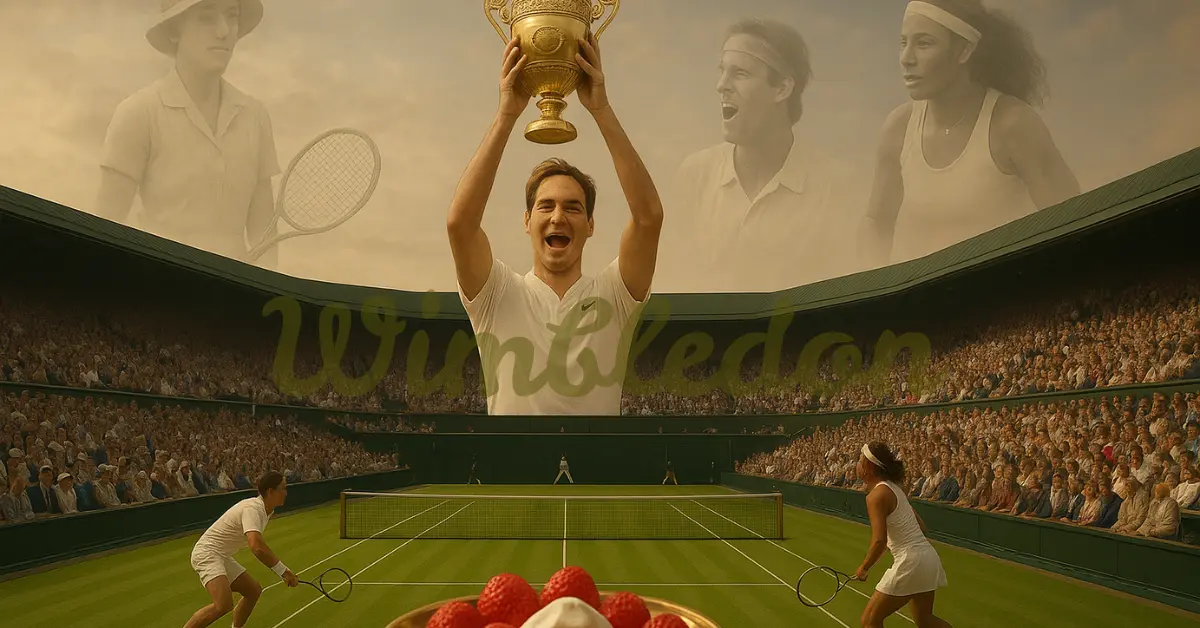Table of Contents
Wimbledon History stands as tennis’s most prestigious stage, where champions are crowned on sacred grass courts that have witnessed nearly a century and a half of sporting excellence. As the oldest tennis tournament in the world, Wimbledon has evolved from a modest Victorian garden party into the sport’s most coveted championship, yet it maintains traditions that connect modern players to the game’s earliest pioneers.
Held annually at the All England Lawn Tennis and Croquet Club in London, this Grand Slam tournament represents more than just athletic competition. It embodies British tradition, sporting excellence, and the enduring appeal of a game played on nature’s surface. From strawberries and cream to the iconic all-white dress code, Wimbledon’s customs have become as legendary as the champions who have graced its courts.
The tournament’s story spans three centuries, encompassing royal patronage, world wars, social change, and technological revolution. Through it all, Wimbledon has maintained its unique character while adapting to meet the demands of modern professional tennis.
Origins and Early Years of Wimbledon History
Founding of the Club
The All England Lawn Tennis and Croquet Club emerged from Victorian England’s sporting enthusiasm in 1868, originally established as the All England Croquet Club. The club’s founders sought to create a venue for croquet enthusiasts in Wimbledon, then a fashionable suburb of London. However, as tennis gained popularity in the 1870s, the club recognized the potential of this emerging sport and added “Lawn Tennis” to its name in 1877.
The First Tournament in Wimbledon History (1877)
The inaugural Wimbledon Championship took place in July 1877, featuring only one event: the Gentleman’s Singles. Twenty-two players competed for the championship, paying an entry fee of one shilling and sixpence. Spencer Gore emerged as the first Wimbledon champion, defeating William Marshall in straight sets before approximately 200 spectators.
Key details of the first tournament:
- Entry fee: 1 shilling and sixpence per player
- Prize: Silver Challenge Cup valued at 25 guineas
- Format: All matches played as best of five sets
- Courts: Grass courts measuring 78 feet by 27 feet
- Attendance: Approximately 200 spectators for the final
Introduction of Events and Expansion
Wimbledon expanded rapidly in its early years, adding new events to meet growing demand:
- 1884: Ladies’ Singles introduced, won by Maud Watson
- 1884: Gentlemen’s Doubles added to the program
- 1913: Ladies’ Doubles and Mixed Doubles events launched
- 1888: Challenge Round system implemented, allowing defending champions automatic qualification to the final
Rulemaking and Evolution
The early tournaments established many conventions that remain central to tennis today. The All England Club became instrumental in standardizing tennis rules, working with other national tennis associations to create uniform regulations. The club’s committee refined scoring systems, court dimensions, and equipment standards that influenced tennis worldwide.
Wimbledon History Through the Ages
Late 19th–Early 20th Century
During this period, Wimbledon established itself as tennis’s premier championship. The tournament attracted international competitors, though participation remained largely limited to amateur players from affluent backgrounds. Notable developments included:
- Introduction of the challenge round system
- Expansion of spectator facilities
- Growing international participation
- Development of distinctive Wimbledon traditions
Venue Relocation
The tournament moved from its original Worple Road location to the current Church Road site in 1922. This relocation allowed for significant expansion and modernization:
- Centre Court capacity increased to accommodate 9,989 spectators
- Improved facilities for players and officials
- Enhanced transportation access for spectators
- Space for future development and additional courts
Historic Milestones
Several landmark moments defined Wimbledon’s evolution:
- 1922: First radio broadcast of Wimbledon matches
- 1937: First television broadcast, reaching approximately 500 viewers
- 1957: Television coverage expanded significantly
- 1968: Beginning of the Open Era, allowing professional players
World Wars Impact
Both World Wars significantly disrupted Wimbledon’s operations:
World War I (1915-1918):
- Tournament cancelled for four consecutive years
- Grounds used for military purposes
- Club facilities converted to support war effort
World War II (1940-1945):
- Six-year tournament suspension
- Centre Court damaged by bombing in October 1940
- Grounds used for civil defense and military training
Post-War Revival
Wimbledon’s post-war return marked a new era of growth and modernization:
- 1946: Tournament resumed with record attendance
- Infrastructure improvements and expansion
- Television coverage revolution
- International participation surge
The Open Era in Wimbledon History
The Open Era Begins (1968)
The 1968 tournament marked tennis history’s most significant transformation, as Wimbledon became the first Grand Slam to allow professional players alongside amateurs. This change revolutionized the sport:
- Prize money introduced for the first time
- Top professional players returned to Grand Slam competition
- Increased media attention and commercial opportunities
- Higher competitive standards across all events
Technological and Structural Updates
Wimbledon embraced technological advancement while preserving its traditional character:
- 1986: Yellow tennis balls adopted for television visibility
- 2007: Hawk-Eye electronic line-calling system introduced
- 2009: Centre Court retractable roof installation completed
- 2019: Court No. 1 received its retractable roof
Equal Prize Money (2007)
Wimbledon became the final Grand Slam to offer equal prize money for men’s and women’s champions. This milestone reflected changing attitudes toward gender equity in professional sports:
- Men’s and women’s singles champions received identical prize amounts
- Total prize money exceeded £14 million
- Symbolic importance for tennis’s commitment to equality
Recent Innovations
Modern Wimbledon continues evolving while honoring tradition:
- Enhanced digital coverage and streaming options
- Improved accessibility features throughout the grounds
- Sustainable practices and environmental initiatives
- Advanced player facilities and training resources
Traditions & Cultural Iconography
Strawberries & Cream (and Champagne)
The tradition of consuming strawberries and cream at Wimbledon dates back to the tournament’s earliest years. This quintessentially British refreshment became synonymous with the championship:
- Approximately 34,000 kilograms of strawberries consumed annually
- Traditional pairing with fresh cream
- Champagne service throughout the grounds
- Symbol of British summer leisure culture
All-White Dress Code & Sponsorship
Wimbledon’s strict all-white clothing rule remains one of tennis’s most distinctive regulations:
- Players must wear predominantly white clothing
- Minimal color accents permitted
- Applies to all visible garments, including undergarments
- Maintains tournament’s traditional aesthetic appeal
- Sponsor logo restrictions preserve classic appearance
Ball Boys/Girls & Fashion Evolution
The ball boy and ball girl program represents Wimbledon’s commitment to involving young people in the championship:
- Selected from local schools through rigorous training programs
- Approximately 250 ball boys and girls serve each tournament
- Distinctive uniforms reflecting tournament colors
- Training begins months before the championship
- Many alumni pursue careers in tennis or sports administration
Royal Connections
Wimbledon maintains strong ties with the British Royal Family:
- Regular royal attendance at matches
- The Duke of Kent serves as club president
- Royal patrons present trophies to champions
- Royal Box reserved for distinguished guests
- Ceremonial aspects enhance tournament prestige
Iconic Players in Wimbledon History and Records
Wimbledon’s grass courts have witnessed legendary performances from tennis’s greatest champions. Record holders include:
Men’s Singles:
- Roger Federer: 8 titles (2003-2007, 2009, 2012, 2017)
- Pete Sampras: 7 titles
- Novak Djokovic: 7 titles
Women’s Singles:
- Martina Navratilova: 9 titles
- Steffi Graf: 7 titles
- Serena Williams: 7 titles
Notable achievements:
- Longest match: John Isner vs. Nicolas Mahut (2010) – 11 hours, 5 minutes
- Most consecutive titles: Björn Borg (5 consecutive men’s titles, 1976-1980)
- Youngest champion: Martina Hingis (1997, age 16)
Infrastructure Development in Wimbledon History
The All England Club has undergone continuous development while preserving its historic character:
Court Facilities:
- 18 championship courts, including Centre Court and Court No. 1
- All courts maintain natural grass surfaces
- Two courts feature retractable roofs for weather protection
- Practice courts available for player preparation
Spectator Amenities:
- Multiple restaurants and hospitality venues
- Wimbledon Lawn Tennis Museum
- Shopping facilities featuring official merchandise
- Accessible facilities throughout the grounds
Sustainability Initiatives:
- Environmental management programs
- Waste reduction and recycling systems
- Water conservation measures
- Carbon footprint reduction efforts
Cultural Impact & Legacy
Wimbledon’s influence extends far beyond tennis, shaping British culture and global sporting traditions. The tournament represents:
Cultural Significance:
- Symbol of British summer tradition
- Integration with national identity
- Literary and artistic inspiration
- Fashion and style influence
Global Reach:
- Broadcast to over 200 countries worldwide
- International tourism destination
- Economic impact on local community
- Inspiration for tennis facility development globally
Sporting Legacy:
- Standard-bearer for professional tennis
- Innovation in tournament organization
- Player development and support
- Tennis popularity promotion worldwide
Timeline Overview
| Year | Milestone |
| 1877 | First Wimbledon Championship held |
| 1884 | Ladies’ Singles and Gentlemen’s Doubles introduced |
| 1922 | Tournament moves to Church Road |
| 1937 | First television broadcast |
| 1968 | Open Era begins |
| 1986 | Yellow tennis balls adopted |
| 2007 | Equal prize money introduced |
| 2009 | Centre Court retractable roof completed |
| 2019 | Court No. 1 receives retractable roof |
A Lasting Testament to Tennis Excellence
Wimbledon’s 147-year journey from Victorian garden party to global sporting spectacle demonstrates the enduring power of tradition combined with thoughtful innovation. The championship has successfully navigated world wars, social change, and technological revolution while maintaining the essential character that makes it tennis’s most prestigious event.
The tournament’s future promises continued evolution as it adapts to changing media consumption, environmental concerns, and global sporting demands. Yet the fundamental elements that define Wimbledon—grass court tennis, British tradition, and sporting excellence—will undoubtedly endure.
For tennis players worldwide, Wimbledon remains the ultimate goal, representing not just championship victory but entry into a legacy that spans nearly 150 years. The tournament’s ability to honor its past while embracing its future ensures that Wimbledon will continue inspiring new generations of tennis champions and enthusiasts for decades to come.

Saurabh is a passionate tennis content writer and lifelong fan of the game. Whether it’s Grand Slam showdowns or under-the-radar rising stars, Saurabh brings the court to life with sharp analysis, breaking news, and deep-dive features. When they aren’t covering matches, you can find them practicing their topspin forehand or debating who is the GOAT over coffee. Do you enjoy tennis? Then you are in the right place.




